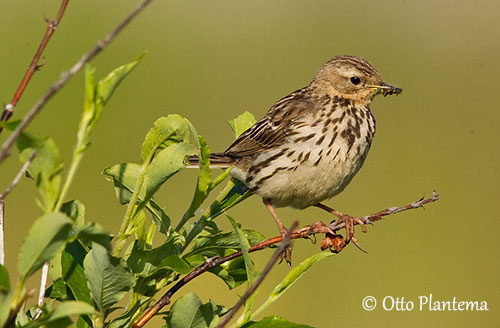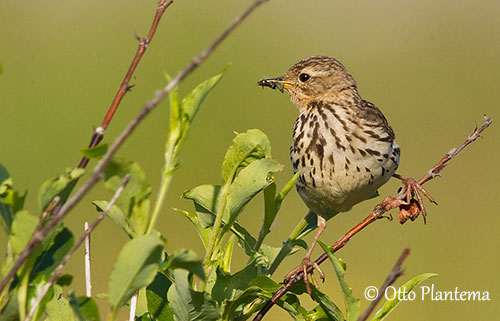
The Pechora Pipit nests on the ground among the low vegetation. This species is territorial and probably monogamous. Some loose colonies have been observed.
The male performs a song flight during which it raises high into the air, often to 30-70 metres, and then, it flies in circles with rapid wingbeats, and occasionally hovers.
The Pechora Pipit is a long-distance migrant. The species may occur in several countries of W Europe with most records from Britain. It leaves the N breeding grounds from mid-September and returns late May and June. It is a rare visitor to Aleutian and St. Lawrence Islands, and W Alaska (in spring).
This species performs series of fairly swift, rapid wingbeats interspersed with wings pulled to the sides.
REPRODUCTION OF THIS SPECIES:
The breeding season takes place in late June/July in Siberia. The Pechora Pipit builds a cup-shaped nest with grass and leaves, and lined with softer material. This structure is placed on the ground, usually among low vegetation, or protected by low scrub or tuft of grass.
The female lays 4-6 grey or green eggs with dark spots. She incubates alone during 12-13 days. Both adults feed the chicks during 12-14 days.
PROTECTION / THREATS / STATUS:
The Pechora Pipit has large range. This species has secretive behaviour making it difficult to see.
The population is suspected to be stable, although the subspecies “menzbieri” seems to be declining in its relatively small range.
However, the Pechora Pipit is not globally threatened and the species is currently evaluated as Least Concern.
Fr: Pipit de la Petchora
Ang: Pechora Pipit
All: Petschorapieper
Esp: Bisbita del Pechora
Ita: Pispola della Pechora
Nd: Petsjorapieper
Sd: tundrapiplärka
Photographer:
Otto Plantema
Trips around the world
Text by Nicole Bouglouan
Sources :
HANDBOOK OF THE BIRDS OF THE WORLD Vol 9 - by Josep del Hoyo - Andrew Elliot - David Christie - Lynx Edicions - ISBN: 8487334695
SORA - The field identification of North American pipits
British Birds - Field identification of Pechora Pipit
Wikipedia, the free encyclopaedia
What Bird-The ultimate Bird Guide (Mitchell Waite)
Pechora Pipit
Anthus gustavi
Passeriformes Order – Motacillidae Family
INTRODUCTION:
The Pechora Pipit is a small pipit streaked brown above and paler below. It breeds in Pechora River Valley in NE Russia, giving the species its name. This long-distance migrant moves to Indonesia in winter.
The Pechora Pipit was first described in 1863 by Robert Swinhoe, an English naturalist, but the scientific name “gustavi” pays tribute to Gustaaf Schlegel, a Dutch naturalist.
This species is primarily an insect-eater and forages mainly on the ground, creeping in tall grass in mouse-like motion. It breeds in damp tundra or marshland and builds the nest on the ground.
The Pechora Pipit has currently stable population and the species is not globally threatened.
DESCRIPTION OF THE BIRD:
Biometrics:
Length: 14 cm
Wingspan: 24-25 cm
Weight: 20-26 g
The Pechora Pipit of nominate race has heavily streaked dark brown upperparts. Mantle and scapulars are black with whitish stripes forming pale “braces”. Back, rump and uppertail-coverts are yellow-buff or sometimes rufous-buff with black streaks. On the upperwing, the wingbars are formed by the pale tips of greater and median wing-coverts. The tail is mostly blackish with white edges to outermost rectrices.
The underparts are buffy, with creamy or white centre of belly. Breast, flanks and sides of belly show conspicuous blackish streaks. On the underwing, coverts and axillaries are greyish washed buff.

On the head, forehead and crown are black with buffy streaks. We can see a long, buffish supercilium. Ear-coverts are ochre-buff with indistinct black streaking and spotting. There is a thin, black malar stripe and a black patch on side of lower throat. The hindneck is buff with black streaks.
The bill has dark brown upper mandible and paler lower mandible. The eyes are dark brown. Legs and feet are pale brown, grey, pinkish or yellowish.
The Pechora Pipit in non-breeding plumage has duller, paler streaking above, whiter wingbars and paler underparts.
Male and female are similar.
The juvenile/immature has less distinct streaking below, with streaks extending to throat and belly.
SUBSPECIES AND RANGE:
The Pechora Pipit has two subspecies.
Anthus g. gustavi is found in N Russia from NW of Urals (W of R. Pechora), E to Chukotskiy Peninsula, S to middle R. Yenisey, middle R. Lena and Kamchatka. It migrates to Philippines, N Borneo and Wallacea.
Anthus g. menzbieri occurs in Russian Far East and extreme NE China. It winters in Philippines.
This race has shorter wings, more extensive black above and narrower and paler feather edges, whereas underparts are deeper yellow-buff with darker buff undertail-coverts.
HABITAT:
The Pechora Pipit breeds in wet meadows with sedges and reedgrass, in marshes, and also in slightly elevated tundra with dense shrubs, not flooded during high water-level periods. During winter, it can be found in wet grassy areas and open forest.
CALLS AND SONGS: SOUNDS BY XENO-CANTO
The Pechora Pipit gives a hard “pwit” or “pit”. The song is a series of high-pitched wheezy notes often uttered while hovering up to 40 metres during the aerial displays.
BEHAVIOUR IN THE WILD:
The Pechora Pipit feeds mainly on various insect species such as Odonata, Hymenoptera, Coleoptera, Diptera, Ephemeroptera and Lepidoptera. It also takes spiders and molluscs.
It forages primarily on the ground and picks food items from the lower parts of plants, stems and leaves. It may occasionally forage in tree branches.
